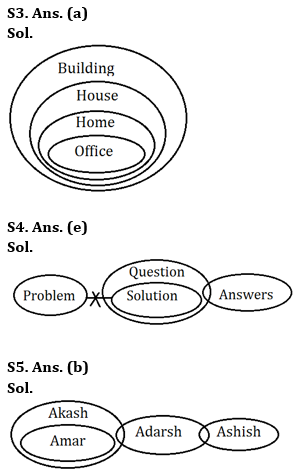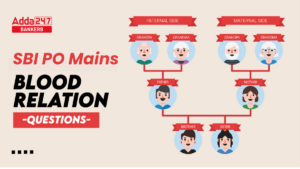Directions (1-5): In each of the questions below some statements are given followed by two conclusions. You have to take the given statements to be true even if they seem to be at variance with commonly known facts. Read all the conclusions and then decide which of the given conclusions logically follows from the given statements disregarding commonly known facts.
(a) If only conclusion I follows.
(b) If only conclusion II follows.
(c) If either conclusion I or II follows.
(d) If neither conclusion I nor II follows.
(e) If both conclusions I and II follow.
Q1. Statements: Some America is USA.
All England is Europe.
No England is America.
Conclusion: I: Some USA is Europe.
II: No USA is Europe.
Q2. Statements: All Assistant is Clerk.
Some Clerk is PO.
All PO is Manager.
Conclusion: I: Some Clerk is Manager.
II: All Clerk is Manager.
Q3. Statements: All Home is House.
All Office is Home.
All House is Building.
Conclusion: I: Some Home is Building.
II: No Home is Building.
Q4. Statements: No Problem is Solution.
All Solution is Question.
Some Question is Answers.
Conclusion: I: Some Solution being Answers is a possibility.
II: No Solution being Answers is a possibility.
Q5. Statements: Only Akash is Amar.
Only a few Akash is Adarsh.
Few Adarsh is Ashish.
Conclusion: I: Some Amar is Ashish.
II: Some Adarsh is Akash.
Directions (6-10): In these questions the symbols #, ©, π, $ and % are used with different meanings as given below:
‘A# B’ means ‘A is smaller than B’
‘A © B’ means ‘A is greater than B’
‘A π B’ means ‘A is either smaller than or equal to B’
‘A $ B’ means ‘A is either greater than or equal to B’
‘A % B’ means ‘A is neither smaller nor greater than B’
In each of the following questions, assuming the given statements to be true, find out which of the two conclusions I and II given below them is/are definitely true. Give answer
(a) if only conclusion I is true.
(b) if only conclusion II is true.
(c) if either conclusion I or II is true.
(d) if neither conclusion I nor II is true.
(e) if both conclusions I and II are true.
Q6. Statement: L $ M % Q © S # T π P
Conclusions: I. P©M II. P π Q
Q7. Statement: W # H π I % C $ H © S
Conclusions: I. W#S II. C$W
Q8. Statement: W % X © Y π Z © R % L
Conclusions: I. W© L II. X π R
Q9. Statement: A # N % O π T π H # E
Conclusions: I. H % O II. H©N
Q10. Statement: P © V % T # D # M $ F
Conclusions: I. D ©V II. P © T
Solutions


Solutions (6-10):
S6. Ans. (c)
S7. Ans. (d)
S8. Ans. (c)
S9. Ans. (c)
S10. Ans. (e)





 GA Capsule for SBI Clerk Mains 2025, Dow...
GA Capsule for SBI Clerk Mains 2025, Dow...
 The Hindu Review October 2022: Download ...
The Hindu Review October 2022: Download ...
 Important Blood Relation Questions for S...
Important Blood Relation Questions for S...





